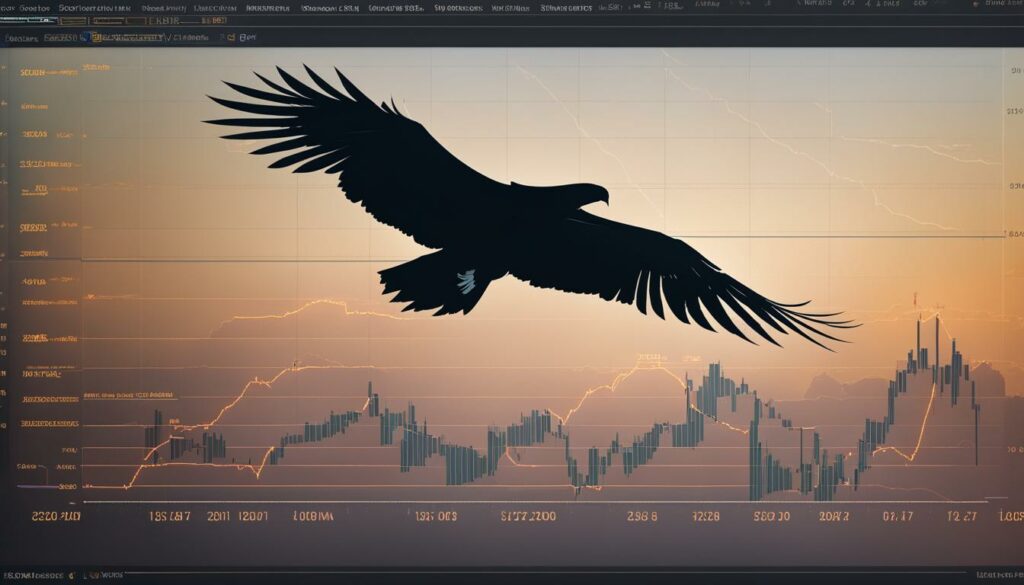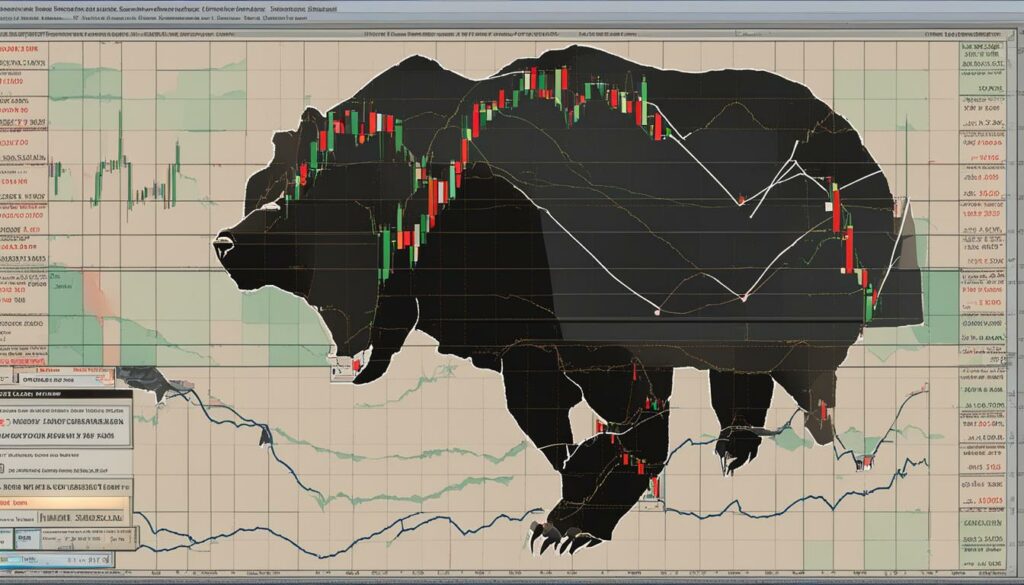Iron Condor: A Limited Risk Options Strategy

An iron condor is an options strategy that offers traders a way to manage risk and potentially profit from low volatility in the market. This strategy involves four options with the same expiration date and consists of two puts and two calls, along with four strike prices. By combining these options, traders can create a position that has limited upside and downside risk.
The goal of an iron condor is to earn the maximum profit when the underlying asset closes between the middle strike prices at expiration. This strategy is popular among options traders because it provides the opportunity to generate income while limiting potential losses.
Key Takeaways:
- An iron condor strategy involves four options with the same expiration date and four strike prices.
- The maximum profit is earned when the underlying asset closes between the middle strike prices.
- Iron condors provide limited risk and potential income for options traders.
- This strategy is designed to profit from low volatility in the market.
- Traders should carefully manage risk and adjust the position as needed.
Understanding the Iron Condor Strategy
The iron condor strategy is a popular options trading strategy that is often used by both beginner and experienced traders. It is a delta-neutral strategy, which means that it aims to profit from low volatility in the underlying asset. This strategy involves selling an out-of-the-money bear call credit spread above the stock price and an out-of-the-money bull put credit spread below the stock price, both with the same expiration date.
By using this strategy, traders can benefit from limited risk and limited rewards. The maximum profit is achieved when the price of the underlying asset remains between the two short strike prices at expiration. The maximum loss is limited to the difference between the long call and short call strikes, or the long put and short put strikes. However, the loss can be reduced by the net credits received when initiating the trade.
To better understand the iron condor strategy, it’s important to know that it consists of four options: a long put further out of the money (OTM), a short put closer to the money, a long call further OTM, and a short call closer to the money. The strategy can be adjusted by selecting different strike prices, allowing traders to lean bullish or bearish based on market conditions.

Key Points:
- The iron condor strategy profits from low volatility in the underlying asset.
- It involves selling an out-of-the-money bear call credit spread and an out-of-the-money bull put credit spread.
- The strategy has limited risk and limited reward.
- The maximum profit is earned when the price of the underlying asset remains between the two short strike prices at expiration.
- The maximum loss is limited to the difference between the long call and short call strikes, or the long put and short put strikes.
Iron Condor Profits and Losses
The iron condor strategy offers traders limited risk and limited reward. Understanding the potential profits and losses associated with this options strategy is crucial for successful trading.
The maximum profit for an iron condor is the premium, or credit, received when creating the four-leg options position. This premium is earned upfront and represents the maximum potential gain for the trade. The goal is for the underlying asset to close between the middle strike prices at expiration, allowing the trader to keep the full credit received as profit.
On the other hand, the maximum loss for an iron condor is limited to the difference between the long call and short call strikes, or the long put and short put strikes. If the price of the underlying asset moves beyond the long strike prices, the maximum loss will be realized. However, the loss can be mitigated by the net credits received when placing the trade. It’s important to consider commissions when calculating the overall loss of the position.
| Profit Potential | Loss Potential | |
|---|---|---|
| Iron Condor | Maximum profit is the premium received. | Maximum loss is the difference between the long and short strike prices, minus the net premium received. |
Managing risk is a crucial aspect of trading iron condors. Traders should be aware of the potential losses and have a plan in place to adjust or exit the position if necessary. The maximum profit and loss potential should be considered when evaluating the risk-reward ratio of an iron condor trade.
Iron Condor Market Outlook
An iron condor is a market-neutral options strategy that thrives in low volatility environments. It is particularly suitable when the expectation is for the underlying asset’s price to remain range-bound before expiration. Traders who employ the iron condor strategy anticipate that the implied volatility will decrease, allowing them to profit from time decay and non-directional price movements.
By executing an iron condor, traders aim to take advantage of the premium received by selling out-of-the-money (OTM) call and put options. These OTM options have lower premiums compared to the closer-to-the-money options that are bought to provide downside protection. The combination of these positions creates a limited-risk trade with a capped potential profit.
Iron condors provide traders with more flexibility compared to directional strategies, as they do not require predicting the market’s exact direction. Traders can adjust the strike prices and width of the condor spread to align with their market outlook, allowing for bullish, bearish, or neutral biases within the range of the selected strikes. It is important to note that while the iron condor offers a limited risk-reward profile, it does require diligent risk management to mitigate potential losses.

Iron Condor Market Outlook
| Market Condition | Expected Result |
|---|---|
| Low Volatility | Profit from time decay and range-bound price movements |
| Implied Volatility Decrease | Lowers option premiums, benefiting iron condor traders |
| Non-Directional Price Movements | Allows traders to profit regardless of the market’s exact direction |
Setting Up an Iron Condor
To set up an iron condor, you will need to sell an out-of-the-money bear call credit spread above the stock price and an out-of-the-money bull put credit spread below the stock price. Both spreads should have the same expiration date. This options strategy allows you to collect a credit when establishing the position, which represents the maximum profit potential for the trade.
The maximum risk for an iron condor is defined by the width of the spread minus the credit received. Adjusting the distance from the current stock price and the size of the spread between the short and long options can help tailor the strategy to your desired risk level. It’s important to note that as with any options strategy, there is no guarantee of profit, and losses can occur if the price of the underlying asset moves outside the breakeven points.
Example:
Let’s say XYZ stock is trading at $100, and you decide to set up an iron condor with the following options:
- Sell one XYZ $110 call option for a credit of $2
- Buy one XYZ $115 call option for a debit of $1
- Sell one XYZ $90 put option for a credit of $2
- Buy one XYZ $85 put option for a debit of $1
In this example, the combined credit received from selling the call and put options is $4 ($2 for each spread). This represents the maximum profit potential for the trade. The maximum risk is determined by the width of the spreads ($115 – $110 = $5 for the call spread and $90 – $85 = $5 for the put spread) minus the credit received ($10 – $4 = $6). Therefore, the maximum risk for this iron condor is $6.
Table: Iron Condor Setup
| Leg | Option Type | Strike Price | Credit/Debit |
|---|---|---|---|
| 1 | Call | $110 | -$2 |
| 2 | Call | $115 | +$1 |
| 3 | Put | $90 | -$2 |
| 4 | Put | $85 | +$1 |
By setting up an iron condor, you can take advantage of low volatility and non-directional price movements in the market. This strategy can be particularly useful for beginners looking to explore options trading. However, it’s important to have a solid understanding of the potential risks and to carefully manage your positions.

Iron Condor Payoff Diagram
The iron condor payoff diagram provides a visual representation of the potential profit or loss for this options trading strategy. It resembles a bird’s body and wings, with the central body representing the maximum profit zone and the wings representing the potential loss zones.
When the price of the underlying asset closes between the two short strike prices at expiration, the iron condor strategy generates its full credit received as profit. This occurs because both the short call and short put options expire out of the money, resulting in the premium collected as profit.
If the price of the underlying asset moves above or below one of the long strike prices, the iron condor strategy incurs its maximum loss. At this point, both the long call and long put options expire out of the money, resulting in the loss of the premium paid for these options.

Iron Condor Payoff Diagram Example
To illustrate the iron condor strategy’s payoff diagram, consider the following example:
| Option | Strike Price | Type | Premium |
|---|---|---|---|
| Short Call | $110 | Call | $3 |
| Long Call | $120 | Call | $1 |
| Short Put | $90 | Put | $2 |
| Long Put | $80 | Put | $1 |
In this example, the iron condor strategy is established with the following options:
- A short call option with a strike price of $110 and a premium of $3
- A long call option with a strike price of $120 and a premium of $1
- A short put option with a strike price of $90 and a premium of $2
- A long put option with a strike price of $80 and a premium of $1
Based on the strike prices and premiums, the iron condor strategy’s maximum profit would occur if the underlying asset closes between the short call strike ($110) and the short put strike ($90) at expiration. The maximum loss would be realized if the underlying asset moves above the long call strike ($120) or below the long put strike ($80) at expiration.
Exiting and Adjusting an Iron Condor
When trading an iron condor, it is important to have a plan in place for exiting or adjusting the position before expiration. This allows you to secure profits or minimize losses, depending on market conditions and your risk management strategy. There are several ways to exit or adjust an iron condor.
1. Closing Individual Options:
If one side of your iron condor is in the money and reaching the short strike, you can choose to close that individual option to mitigate potential losses. This allows you to reduce your risk and potentially salvage some of the initial credit received when opening the position. However, keep in mind that closing individual options may impact the overall risk-reward profile of your iron condor.
2. Exiting the Entire Position:
If the market conditions have changed significantly or your iron condor is no longer profitable, you can choose to exit the entire position. This involves buying back all four options that make up the iron condor. By doing so, you can lock in any remaining profits or limit your losses.
3. Adjusting the Iron Condor:
In some cases, it may be possible to adjust your iron condor to accommodate changing market conditions. For example, if the price of the underlying asset moves beyond one of the short strikes, you can consider rolling the affected side of the iron condor to a wider spread or a different strike price. This adjustment allows you to extend the duration of the trade and potentially increase the breakeven points.
Remember, risk management is crucial when trading iron condors. Always have a plan in place for exiting or adjusting your position to protect yourself against unexpected market moves and ensure the long-term success of your trading strategy.

Table: Iron Condor Exit and Adjustment Strategies
| Strategy | Description |
|---|---|
| Closing Individual Options | Close options that are reaching the short strike to mitigate losses and reduce risk. |
| Exiting the Entire Position | Buy back all four options to lock in profits or limit losses. |
| Adjusting the Iron Condor | Roll the affected side of the iron condor to a wider spread or different strike price to accommodate changing market conditions. |
Time Decay and Implied Volatility Impact on Iron Condors
In options trading, time decay and implied volatility play significant roles in determining the profitability of iron condor strategies. Understanding how these factors impact the trade can help traders make informed decisions and optimize their positions.
Time Decay (Theta)
Time decay, also known as theta, refers to the erosion of an option’s value as it approaches its expiration date. This decay occurs at an accelerated rate in the final weeks and days leading up to expiration. For iron condors, time decay works in favor of the trader who sells the options. As each day passes, the time value of the options decreases, resulting in a decrease in option premiums. This is beneficial for iron condor sellers as they aim to collect a credit when opening the trade and can buy back the options at a lower price, thus realizing a profit.
Implied Volatility
Implied volatility represents the market’s expectation of future price fluctuations of the underlying asset. It is a crucial component in determining the price of options. When implied volatility is high, option premiums tend to be more expensive, reflecting the potential for larger price swings. On the other hand, when implied volatility is low, option premiums are generally lower due to the expectation of smaller price movements. Iron condors benefit from a decrease in implied volatility, as it leads to a reduction in option premiums. This can increase the probability of achieving the maximum profit on the trade.
It’s important to note that while time decay and implied volatility impact iron condors, they are not the only factors to consider. Market conditions, price movements, and overall risk management should also be taken into account when trading iron condors.

Summary
- Time decay, or theta, works in favor of iron condor traders as it erodes the value of options over time, benefiting those who sell options to open the trade.
- Implied volatility plays a significant role in determining the price of options and can impact the profitability of iron condor strategies. A decrease in implied volatility can lead to lower option premiums, increasing the probability of achieving the maximum profit on the trade.
- While time decay and implied volatility are important factors to consider, traders should also take into account market conditions, price movements, and risk management strategies when trading iron condors.
| Time Decay | Implied Volatility | |
|---|---|---|
| Effect | Erodes option value | Influences option premiums |
| Benefit for Iron Condor Traders | Decreases option premiums | Reduces option premiums |
Rolling an Iron Condor
Rolling an iron condor is a strategic move that can be made when the original position is not performing as expected. This adjustment allows traders to extend the duration of the trade and potentially widen the break-even points. The decision to roll an iron condor depends on market conditions and the trader’s risk management strategy.
When rolling an iron condor, the existing position is closed, and a new position is opened with a later expiration date. This can be done by buying back the short options and selling new options at different strike prices. By rolling the iron condor, traders can give themselves more time for the underlying asset to move within the desired range.
Rolling an iron condor can also be used to adjust the position if the market conditions have changed. For example, if the underlying stock price has moved closer to one of the short strike prices, a trader may decide to roll the unchallenged spread in the direction of the stock’s price movement. This adjustment helps manage risk and potential losses.
Example of Rolling an Iron Condor
Let’s consider an example to illustrate how rolling an iron condor works. Suppose a trader initially establishes an iron condor with the following parameters:
| Position | Strike Price | Expiration Date |
|---|---|---|
| Short Call Spread | $50 – $55 | October 1 |
| Short Put Spread | $45 – $40 | October 1 |
If, during the course of the trade, the underlying stock price rises and approaches the short call strike price of $50, the trader may decide to roll the unchallenged spread. They could buy back the short $50 call and sell a new call option with a higher strike price, such as $60. This adjustment would give the trader a wider range for the stock price to stay within, potentially reducing the risk of loss.
It’s important for traders to carefully analyze market conditions and assess the potential risks and rewards before deciding to roll an iron condor. Risk management and a thorough understanding of options strategies are key to successful trading.
Hedging an Iron Condor
When trading an iron condor options strategy, it is important to have a solid risk management plan in place. While this strategy has limited risk, it is still crucial to consider potential losses and how to mitigate them. One effective way to hedge an iron condor is by rolling the unchallenged spread in the direction of the underlying stock’s price movement.
By adjusting the trade and rolling the spread, you can manage risk and minimize potential losses. This strategy allows you to adapt to changing market conditions and protect your investment. However, the specific hedging approach will depend on your individual goals and market analysis.
| Hedging an Iron Condor | Benefits |
|---|---|
| Rolling the unchallenged spread | – Manages risk – Minimizes potential losses – Allows for adjustment to changing market conditions |
When rolling the unchallenged spread, you are essentially extending the duration of the trade and potentially widening the break-even points. This can provide you with more flexibility and increase the chances of a favorable outcome.
It is important to note that hedging an iron condor requires careful consideration and analysis. You should closely monitor the market and assess the potential impact of any adjustments on your overall trade. By effectively hedging your iron condor, you can improve your risk management and increase the likelihood of a successful trade.
Hedging an iron condor is an essential aspect of options trading strategies, particularly for managing risk and minimizing potential losses. By rolling the unchallenged spread in the direction of the underlying stock’s price movement, traders can adapt to changing market conditions and protect their investment. Proper risk management and analysis are crucial when implementing hedging strategies and adjusting iron condor trades to ensure favorable outcomes.
Conclusion
The iron condor is a popular options trading strategy that allows traders to profit from low volatility and non-directional price movements. By utilizing four options with the same expiration date, the iron condor provides a limited risk and limited reward scenario, making it an attractive choice for certain market conditions.
Successful trading of iron condors requires a thorough understanding of the strategy, as well as effective risk management techniques. Traders must be proficient in adjusting and adapting to changing market conditions in order to optimize their results.
Overall, the iron condor strategy offers traders the opportunity to achieve consistent profits in a range-bound market environment, while effectively managing their risk exposure. By utilizing sound options trading strategies and implementing robust risk management practices, traders can navigate the market with confidence and maximize their potential returns.
FAQ
What is an iron condor?
An iron condor is an options strategy that involves four options with the same expiration date. It consists of two puts (one long and one short) and two calls (one long and one short), along with four strike prices.
How does an iron condor strategy work?
The goal of an iron condor is to profit from low volatility in the underlying asset. This strategy has limited upside and downside risk due to the protection provided by the high and low strike options, known as the wings. The maximum profit is earned when the underlying asset closes between the middle strike prices at expiration.
What is the maximum profit and maximum loss for an iron condor?
The maximum profit for an iron condor is the premium, or credit, received when creating the four-leg options position. The maximum loss is capped at the difference between the bought and sold call strikes and the bought and sold put strikes, less the net premium received.
When is an iron condor strategy suitable?
Iron condors are market-neutral strategies with no directional bias. They are suitable when the expectation is for the underlying asset’s price to stay range-bound before expiration and for implied volatility to decrease. The strategy profits from low volatility and time decay.
How can an iron condor be closed or adjusted?
An iron condor can be closed or adjusted before expiration to secure a profit or minimize losses. Options can be closed individually or the entire position can be exited. Adjustments may involve rolling one of the spreads to a different strike price or extending the time horizon of the trade.
How does time decay and implied volatility impact an iron condor?
Time decay, or theta, works in favor of iron condor traders. As time passes, the time value of options decreases, benefiting the seller. Implied volatility also has an impact on the pricing of options. Iron condors benefit from a decrease in implied volatility, as it leads to lower option premiums.
What is the purpose of rolling an iron condor to a future expiration date?
The iron condor strategy can be rolled out to a future expiration date if the original position is not profitable. Rolling the position allows for an extension of the trade’s duration and potentially wider break-even points. The decision to roll an iron condor depends on the specific market conditions and the trader’s risk management strategy.
How can an iron condor be hedged?
The most efficient way to hedge an iron condor is to roll the unchallenged spread in the direction of the underlying stock’s price movement. This adjustment helps manage risk and potential losses. The specific hedging approach will depend on the individual trader’s goals and market analysis.







